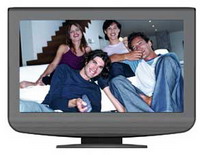|
Chris Iannicello, March 3, 2006
HDTV Solutions
Released in late December with an MSRP of $1299, the LTV-32w3HD will be positioned along side the popular LTV-32w1, which can now be found for about $999. The LTV-32w3 HD contains some significant upgrades over the LTV-32w1, including:
|
My test unit was shipped directly from the manufacturer and was very well packaged. The initial build quality appears very solid as the unit has a very good fit and finish. Westinghouse has designed the LTV-32w3HD with a black front chassis and built-in speakers, a much cleaner look than the multi-toned silver LTV-32w1. This unit has a depth of 4.4 inches when wall-mounted, which is about average for a 32" LCD. Aside from aesthetics, purists will appreciate the black front bezel that supposedly improves perceived contrast. The remote is well designed, with dedicated buttons for each input, and three Favorites buttons that can each store a specific channel. The User Guide is easy to understand and navigate.
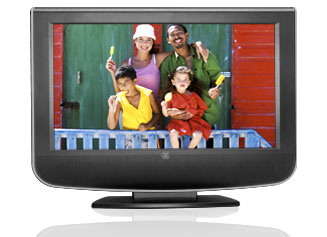 |
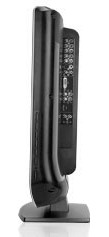 |
| Westinghouse LTV-32w3 HD LCD TV | |
 |
| Remote Control |
Westinghouse also claims improved picture quality because SpineDesign "incorporates a single board to shorten the signal path from video sources to the panel." I'm not sure about the shorter signal path claim, but I must admit it is a lot easier to hook up components compared to many other flat panel displays as the inputs are pointing to the sides of the panel, which means you can see the inputs clearly by simply looking from the side as opposed to having to go behind or underneath the display. This becomes even more important when mounting to a wall, as many displays require you to break out a flashlight and small mirror to plug in a component.
Under the Hood
The LTV-32w3HD has a native resolution of 1366x768, which is more than sufficient resolution to display all current HDTV sources. The contrast
ratio is rated at 1000:1, but keep in mind that the way contrast ratio is measured varies depending on the manufacturer. The estimated lamp life is 60,000 hours, which is vastly increased from previous product generations, but is now standard for most current LCD displays. The LTV-32w3 HD boasts a blazing fast 8ms response time, which should make the previously common LCD bugaboo of motion ghosting a thing of the past.
Video inputs include: Composite Video, S-Video In, two Component Video, DVI and HDMI, VGA, and Cable In. Other features include 10-bit video processing, which is also common on many current LCD displays.
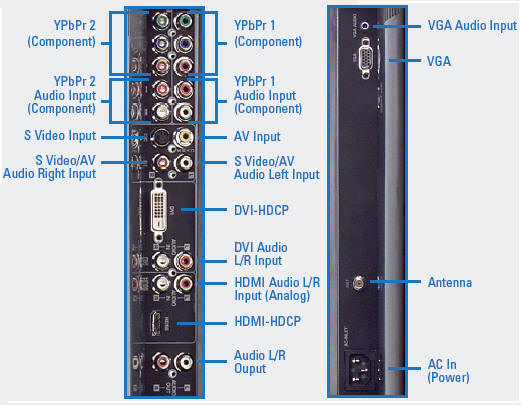 |
| Connections |
Test Drive
I connected the LTV-32w3 HD to the Scientific Atlanta 8300HD Cable box via the HDMI input. I sampled several types of high definition content including movies, sports, and regular television programming, all of which looked bright and sharp. Here are a few sample images of the LTV-32w3HD, set at factory defaults, compared to the BenQ PE7700 DLP Projector (The LTV32w3 HD is the bottom image). It should be noted that PE7700 is a front projector with an image size of 92" and in a different price range (about $2000) than the LTV-32w3HD, so it is not surprising that the PE7700 produces a better overall image in most cases.
Super Bowl XL (ABC HD - 720p)
Facial tones appear muted due to blue-cast and lack of color saturation.
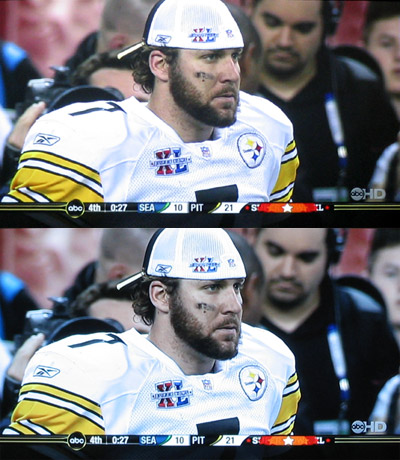 |
| Super Bowl XL (ABC HD, 720p) TOP: BenQ PE7700 BOTTOM: LTV-32w3 HD |
2006 Grammy Awards (CBS HD - 1080i)
Excessive contrast is apparent here, which gives a punchy image and lacks smooth mid-tones.
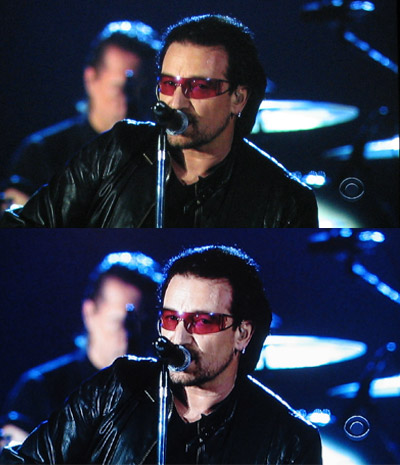 |
| 2006 Grammy Awards TOP: BenQ PE7700 BOTTOM: LTV-32w3 HD |
Miami Heat vs NJ Nets (Yes Network HD - 1080i)
With this image, the LTV-32w3 HD actually does quite well with shadow detail. Notice the amount of fans you can see in the stands. However, one look at Shaq's red jersey and you will notice a significant lack of color saturation compared to the reference image.
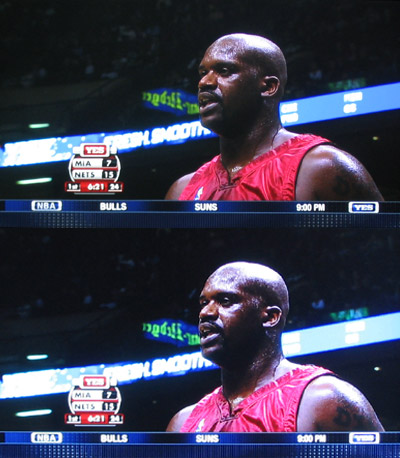 |
| Shaq TOP: BenQ PE7700 BOTTOM: LTV-32w3 HD |
Sin City (HBO HD - 1080i)
In this black and white scene, the blue-cast of the LTV-32w3 HD is obvious. Resolution and shadow detail are very good in this scene.
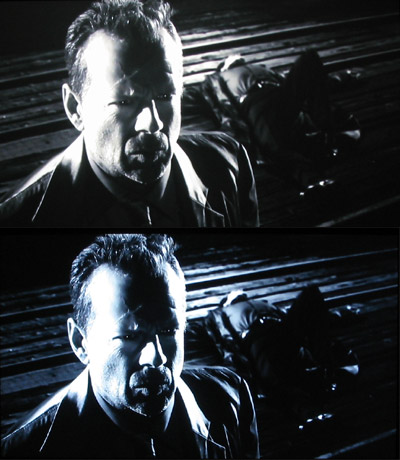 |
| Sin City TOP: BenQ PE7700 BOTTOM: LTV-32w3 HD |
Master and Commander (HBO HD - 1080i)
The LTV-32w3 HD gives a very vibrant image in this scene, but it is at the expense of some mid-range and shadow detail. Notice how you can see more overall facial detail in the reference image.
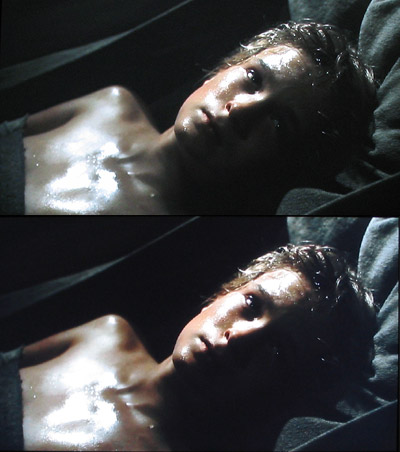 |
| Master and Commander TOP: BenQ PE7700 BOTTOM: LTV-32w3 HD |
Color
As you can see from the sample photographs, the transition from lights to darks is slightly abrupt compared to the reference image. This also results in less then ideal color saturation, with slightly subdued flesh tones. You can increase the color control to improve saturation, but then other issues appear like "red push" and cartoon-like colors with certain types of broadcasts. I found a few clicks above the factory default color level to be ideal.
There is also moderate blue-cast with whites and very light colors, which would suggest the color temperature is above the standard 6500K. There is no dedicated color temperature or white level controls, which is interesting considering the LTV-32w1 contains several color temperature settings and the image quality of the LTV-32w3 HD could be significantly improved if Westinghouse had decided to retain this feature. That being said, the blue-cast may not be distracting for most viewers as many televisions lean towards a blue vs. red-cast as it improves brightness and gives the images a fresh or cool quality.
Contrast/Black Levels
Black Levels, or lack thereof, have been one of the primary gripes of LCD television technology over the years, but have been making well-documented strides from mediocrity to acceptability. To be sure, no LCD has yet to be mistaken for a high-quality plasma or CRT display. But the gap is shrinking, and the LTV-32w3 HD is no exception.
Black levels are very respectable and there were times I caught myself actually forgetting I was watching an LCD, which is a new and positive development. Most regular television programming and live broadcasts were very dynamic, with plenty of overall contrast, but I've found that the true acid test for black levels is movies, and this is where the slight deficiencies of the LTV-32w3 HD appear. When I say slight, I mean, that blacks are still in the category of dark gray, but they are not any lighter than many DLP televisions I've sampled. This is significant, as for years, one of DLP's major differentiators was significantly better black levels than LCD.
It should be pointed out that from the test images, it appears that some shadow detail is sacrificed when achieving these impressive black levels. Contrast can be reduced from the factory default level to smooth out contrast, but then the black levels start to approach a lighter gray, or what I call "clay" gray. I'd rather have the punchier image and lose a bit of shadow detail than have typical LCD lighter grays, and based on how the factory default settings are set up, Westinghouse is guessing that most other viewers will also.
Brightness
I found the brightness more than adequate with a very dynamic, vibrant image regardless of ambient light. In fact, if you prefer to watch TV in complete darkness, you may find yourself lowering either the brightness or the backlight control, which adjusts lamp output.
Video Processing
Westinghouse contains a 3D Comb Filter and Motion adaptive de-interlacing, and they seem to do their job very well. Video noise and artifacts were minimal and both HDTV and DVD sources did not show any signs of jaggies during fast-motion scenes. Since this unit's resolution is 1366 x 768, all current video sources have to be scaled to fit the panel's display, and the LTV-32w3 HD seems to be up to the task as all sources seemed to fit naturally. When watching 4:3 material, the Stretch mode does a decent job in filling the entire screen, with most of the horizontal distortion near the edges. As expected, the 8ms seek time did the trick as there was no sign of motion ghosting.
Viewing Angle
Westinghouse claims a viewing angle of 176 degrees (horizontal and vertical) on their spec sheet, which is better than the current 170 degree Industry Standard. During testing, I found the viewing angle a non-issue, which is a good thing. Whether sitting to the side, below, or above the screen, there was almost no negative impact on the image.
Viewing Distance
I found the closest comfortable viewing distance is about 8 feet, which equates to 3.5x screen width. Any closer and you start to see small noise artifacts. 8 feet is about the average suggested viewing distance for most 32" displays.
Sound Quality
The sound quality was adequate, with clear sounding dialogue. However, as with most flat panel displays, don't expect much of a dynamic range with music or movie soundtracks as the two 10-watt speakers have just a hair more power than your average clock radio.
DVD Performance
When connected to the Oppo OPDV971H upconverting DVD Player via the DVI input, the LTV-32w3 HD produces clear, solid images with no sign of interlacing. Not surprisingly, it is immediately obvious that you are watching a DVD and not HDTV, as the image quality is relatively soft. Colors, contrast, and brightness were all consistent with the LTV-32w3HD's HDTV performance. As you would expect, image quality takes a serious hit when using component video cables vs. DVI, however the results are still respectable.
PC Monitor
In addition to the VGA PC input, the LTV-32w3 HD's DVI input can accept PC signals at 1360 x 768 with 1:1 pixel mapping. This is a significant feature because most current PC video cards allow a resolution of 1360x768, but most LCDs do not support this resolution and therefore will scale PC images horizontally to their native 1366 pixels, resulting in a choppy image.
Built In Tuner
One of the new features of the LTV-32w3 HD is the built-in ATSC and NTSC tuners that are combined for seamless viewing with no cable or satellite receiver. However, this unit does not have a cable card slot, so only Over the Air high definition users can get away without hooking up some form of box or receiver. For example, with my digital HD cable connection, I was able to get local HD channels without my cable box, but not any cable HD channels.
When plugging my cable wire into the Cable TV input and turning the television on, it defaults to Channel 2. When attempting to change the channel, a message stating Perform Scan appears and will not allow you to change channels. I assume this means you have to scan for all available channels first, but the problem is the message does not tell you how to do this. You have to navigate to the Menu and select TV/Autoscan to make all your channels available. Hardly what you would call User Friendly.
When the scan is complete, all HD, digital, and analog channels are combined, which is a nice feature. The only potential inconvenience is that you may end up with the digital and analog versions of the same channel next to each other, which can make channel-surfing a little less than ideal. Of course, you can customize your setup and block the analog channels to solve the problem. As you would expect, the analog cable television channels look terrible, with noise artifacts all over the place. Non-HD digital channels were not great either, but noticeably better than analog. The analog and digital video performance is on par with most other HD displays.
Conclusion
With an MSRP of $1299, the LTV-32w3HD is priced lower than many other 32" LCD HDTVs with a built-in tuner and the overall image quality is better than its price suggests. For viewers that do not need a built-in tuner, I would suggest checking out the LTV-32w1 for about $999, as this is a great value if the image quality is anywhere near the LTV-32w3 HD. There are some issues with contrast and color saturation, but they are mild when considering the price, and the overall viewing experience is a positive one. Furthermore, there are definitely some viewers that will prefer the crisp, punchy images that the LTV-32w3 HD produces over a smoother, less dynamic television. Regardless, it is likely that these issues will not be noticed when the LTV-32w3 HD is viewed on its own, as I was not distracted by them during normal viewing. Based on its features, design, and image quality the LTV-32w3HD is a solid choice and good value compared to other 32" LCDs with built-in tuners.



